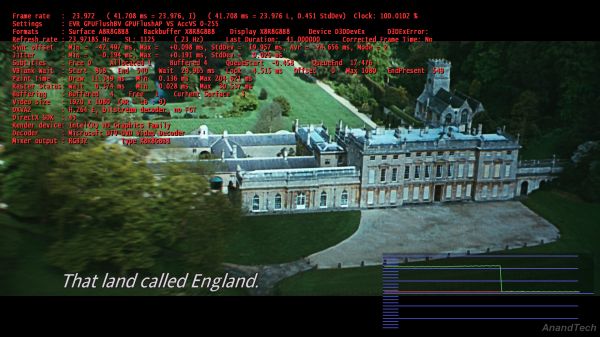ASRock CoreHT 252B Review
by Ganesh T S on September 2, 2011 3:45 AM EST- Posted in
- HTPC
- Intel
- ASRock
- Media Streamer
One of the main issues with Intel's integrated GPU solutions for HTPC users was the absence of 23.976 Hz refresh rate support. When Sandy Bridge was launched, it was discovered that the 23 Hz setting could be activated and made to function as intended if UAC was disabled. With v2372 drivers, the disabling of UAC became unnecessary.
While we don't get perfect 23.976 Hz yet, it is definitely much better than the earlier scenario. Though there are user reports of lip sync still being an issue (particularly when used with a projector), we were unable to corroborate this finding. Personally, I managed to watch two complete movies at their native refresh rate without losing lip sync in our test setup.
23.976 fps Video Playback (MPC-HC/EVR-CP) with 23Hz Refresh Rate Setting
24 fps Video Playback (MPC-HC/EVR-CP) with 24Hz Refresh Rate Setting
The 24 Hz refresh rate feature works as before. Unfortunately, the drifting in the refresh rates doesn't seem to average to 23.976 Hz in the first case. The player locks to 23.972 fps, which implies a skipped frame every 250s (~4 minutes). The scenario seems similar for other refresh rates.
Another aspect we found irritating with Intel's GPU control panel is the custom resolution section. Intel seems very reliant on EDID and doesn't allow the user to input any frequency not supported by the display. I recently got hold of a display (Sony KDL46EX720) to help test 3D as well as multiple refresh rates. Since the unit was sold in the US, it doesn't indicate PAL compatibility in its EDID information. I was able to play back PAL videos with matched refresh rates using the Vision 3D (NVIDIA GT 425M), but Intel's control panel wouldn't allow me to set up 50 Hz as the display refresh rate. It is possible that an EDID override might help, but we can't help complaining about Intel's control panel not being as user friendly as NVIDIA's.
In the next section, we will look at how the integrated GPU in the ASRock CoreHT 252B handles cadence detection and deinterlacing.












54 Comments
View All Comments
uncola - Friday, September 2, 2011 - link
intel really needs to get their shit together re: dxva and hardware decoding for videovlado08 - Friday, September 2, 2011 - link
First I want to tank you Ganesh for the article. Keep the good work!Would you give us some more information please.
Can it play 1080 60p?
There are a lot of camcorders that can record in AVCHD v2.0 (1080 60p 28Mb/s).
What are the temperatures (CPU HDD) inside during idle and 100% load?
Why ASRock don't make CPU fan to blow outside the case as in notebooks?
Can you select RGB or YUV output in new intel drivers?
ganeshts - Friday, September 2, 2011 - link
Yes, it does play 1080p60 without issues (even the Clarkdales and Arrandales can do it).The 1080p60 streams are part of our test suite. But, yet, you are right .. I should have mentioned it.
The HTPC outputs RGB, and there is no obvious way to change it to YUV in the graphics control panel. However, the levels (0-255 / 16-235) can be modified with the Quantization Range option.
I will get back to you on the temperatures in a day.
vlado08 - Friday, September 2, 2011 - link
Thanks Ganesh, is 1080 60p hardware accelerated?ganeshts - Friday, September 2, 2011 - link
Yes, it is.Both 1080p60 and 16 reference frame H.264 videos were able to get DXVA2 hardware acceleration using the Microsoft DTV-DVD decoder.
ganeshts - Friday, September 2, 2011 - link
Here is the temperature info you requested (measured using the AXTU tool for the mobo and the CPU / HD Tune Pro for the hard disk in Celsiuis scale):Idle:
Motherboard : 42
CPU : 44
Hard Disk : 37
Prime95 + Furmark (after 15 minutes of activity):
Motherboard : 48
CPU : 83
Hard Disk : 39
tech6 - Friday, September 2, 2011 - link
I bought a previous generation HT100-BD and it was a fine HTPC but the ASRock service was appaling. The unit had two failed HDMI ports in the first 12 months and the second time ASRock demanded payment to fix it (even tough it was under warranty).As convenient as it may seem, I would go down the DIY route just for the flexibility of being able to fix it yourself.
Rick83 - Friday, September 2, 2011 - link
As paying the Windows Tax for a single purpose/ non-gaming machine is a bit pointless, I wonder how well the hardware in this box cooperates with Linux?I tried to build a HTPC on an older AMD platform and was continually being thwarted by driver issues (WLAN, sound, graphics), but here there actually may be an advantage, as Intel has a developer that manages libva, so their acceleration might work better on linux than DXVA..
Also XBMC has a native linux version which is quite nice and should even boot faster in an optimized system than a Windows system.
Vagn Henning - Friday, September 2, 2011 - link
As you might have noticed, the box ships without Windows. You see, that's the difference between your "Windows tax" and other taxes: You don't have to pay it. You are free to install any other OS. If you stopped pretending otherwise, someone might actually answer your question...Rick83 - Friday, September 2, 2011 - link
Well, the reviewer only used Windows, hence assuming that one pays for it.A Windows-only review is of little help for someone attempting to deploy linux on this box.
If the reviewer implies the windows tax, by not mentioning alternatives, he is the one accepting it, I am merely referring to his point of view.
Also, the alternative to the Windows tax is the Linux tax. The latter can often end up being higher....